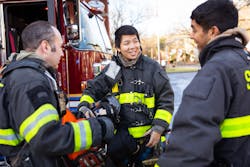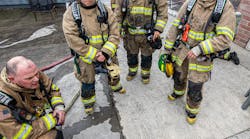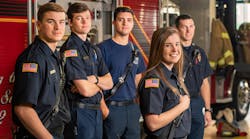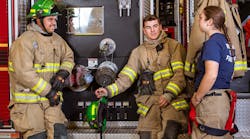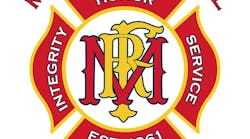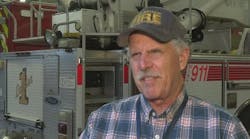This article is part of a larger supplement titled Recruiting and Retaining: The Future of Volunteer Fire Departments. View the supplement in its entirety here.
For decades, fire departments across the United States have depended on volunteers to answer calls and to serve their communities. Some have been very successful in recruiting new volunteers to their ranks, while others have struggled to maintain minimum staffing requirements.
What is the secret to successful recruitment? Why do some departments maintain waiting lists of prospective volunteers while others struggle to keep their doors open?
The community doesn’t know
In 2015, the National Volunteer Fire Council (NVFC) conducted research into volunteer recruitment and retention, seeking to better understand key attitudes and motivators of volunteers. This included a national survey to gauge the public’s awareness of and interest in the volunteer fire service. When asked, “Is your local fire department seeking volunteers?” a whopping 80 percent of respondents didn’t know.
If you’re looking for the low-hanging fruit of volunteer recruitment, create awareness. How are you letting your community know that you need volunteers? Do your company shirts, apparatus and station signage tell the community that you’re a volunteer organization? Are you asking for volunteers every chance that you get? Ask your current members to reach out to their friends, families and coworkers and to share some of the benefits that they received from volunteering (new skills, new friends, knowing that they make a difference in their community). Talk to your local media and ask them to cover a story about a volunteer who made a difference in someone’s life, followed up with information on how to become a volunteer. Attend community events and talk about your volunteer needs and what your department has to offer.
Most importantly, understand that this is an ongoing effort. Consider the “seven times factor” of marketing, which says that customers need to see an ad at least seven times before they buy. You can’t just announce that you need volunteers once. Shout your message as often as you can until your community members buy into the unique and unparalleled experience that your department offers them.
People want to volunteer
We all know the stereotypes: Young people aren’t interested in volunteering. The younger generations don’t feel the same sense of duty to their communities that older generations feel.
Not so fast.
Sure, various life events, from the great depression, to 9/11, to the influx of technology into our daily lives, shape generations and how they view the world that’s around them. However, don’t let stereotypes and assumptions block your path to better recruitment. In the NVFC’s 2015 study, those in the 18–34- age segment were interested significantly more in volunteering than others. Minority respondents indicated as much or more interest in operational volunteer opportunities as their Caucasian counterparts. Although women make up only 4.5 percent of all fire service personnel, this study showed that women are as interested in volunteering as a firefighter or EMT as men. In addition, according to the Corporation for National and Community Service, the overall volunteer rate in the United States went up to 30.3 percent in 2018 from 24.9 percent in 2016.
So, if all of these people are interested in volunteering, why is recruitment so difficult? Much like anything that requires a commitment, people want to know that it will be worth their time and that they will get something out of the effort they put into it. They want to be able to visualize themselves in that role before they commit. Consider the image that your department puts out to the public with your recruitment messages: Can women and minorities see themselves fitting into your department atmosphere? Can younger and older people alike visualize themselves as part of your team? Will they feel welcomed when they join the department? Are new recruits and seasoned members treated with equity and are their contributions appreciated?
Everyone has something to contribute, and these contributions become even more powerful when the group has a rich mix of experiences and backgrounds. View differences not as roadblocks to overcome but, rather, as opportunities for learning, sharing information, new ideas and offsetting weaknesses in one area with strengths in another. When you embrace an inclusive atmosphere where all are valued and appreciated for what they bring to the table, your department will be a place where people want to be.
They have what it takes
The NVFC’s research shows that there are a number of reasons why people volunteer in the fire and emergency services. These include friendships and camaraderie, a desire to help others and their community, learning new skills and because they like excitement. On the flip side, there are a number of reasons why people don’t volunteer. These include self-perceptions, such as:
- They don’t have the physical attributes of a volunteer;
- They can’t be fully committed to the job;
- They don’t have the right skillset for the job; and
- They don’t have enough information about job expectations and the application process.
In a field in which confidence and skill are a must—where lives depend on the ability of one or more people to do their job and do it well—is it any wonder that prospective volunteers have concerns about their ability to do this successfully? Just because people aren’t knocking on your station door with the self-assuredness that this job is for them doesn’t mean that they aren’t capable and needed. Be honest about expectations when talking to prospective volunteers. Let them know that they’ll receive training and what the training requirements are (and be flexible with training to meet their schedule). Tell them what a typical duty shift looks like and about the types and frequency of calls to which your department responds. Nobody wants to commit to the unknown, and nobody wants to feel duped when they commit to something that isn’t at all what they expected.
Research also shows that current volunteers were more likely to join their department after being given a taste of what it’s like to volunteer. Prospective volunteers who aren’t sure that they have the physical skills and attributes for the job can be shown that they do have what it takes. Provide a sampling event where they can experience the life of a volunteer. Let them participate in an extrication demonstration or use a fire hose at your department open house. Invite them for a ride-along, so they can see what happens on an emergency call and the camaraderie that takes place when things are quiet at the station. Providing these opportunities to sample the life of a volunteer helps people to see themselves in that role, to overcome fear and to start to form important human connections that both attract and retain volunteers.
People want to be invited
One of the most effective steps that you can take to grow your ranks is to personally invite people to volunteer. Research shows that most volunteers joined because they were personally invited by a family member or friend.
This doesn’t mean just posting a “volunteers needed” message on your station marquee or placing an ad in your local newspaper. Sure, these actions create awareness of the volunteer need, but if you want to draw in people, personally invite them to join. Invite friends, family members, neighbors, coworkers and people who you meet within your community to join your department. When you personally invite someone to volunteer alongside you, you effectively are telling them that you believe that they have what it takes to do the job, and that might be just the nudge that they need to set their self-doubt aside and give it a chance.
Recruitment isn’t easy, and it’s undoubtedly more of a marathon than a sprint, but understanding your audience and the barriers that they face in volunteering is helpful to recruitment success. Research indicates there is a largely untapped audience of prospective volunteers of women and minorities who are very interested in volunteering and possibly an even larger untapped audience of individuals who simply need to be shown that they have what it takes and are invited to participate.
About the Author
Sarah Lee is the deputy chief executive of the National Volunteer Fire Council (NVFC). Among her roles at the NVFC, she manages the organization’s recruitment and retention initiatives, including the SAFER-funded Make Me A Firefighter campaign.
